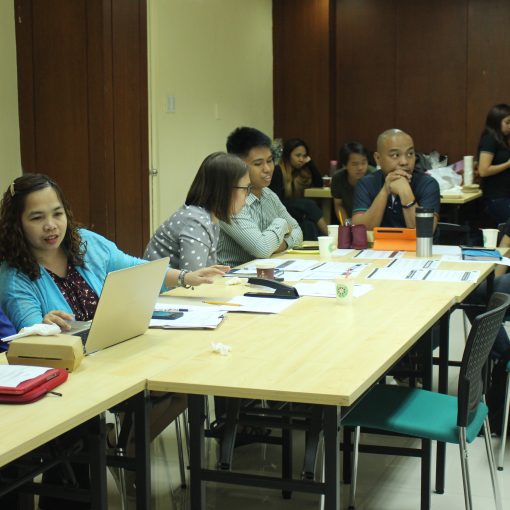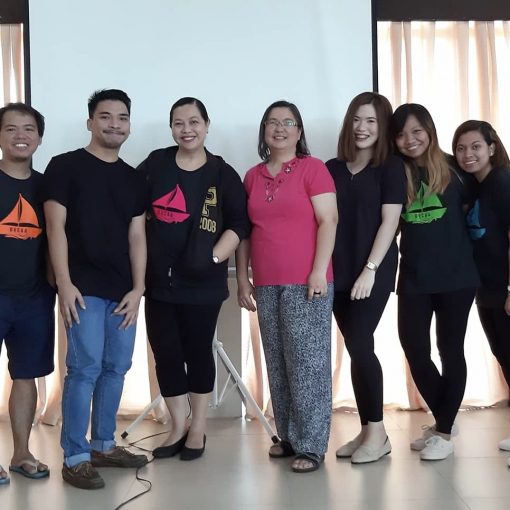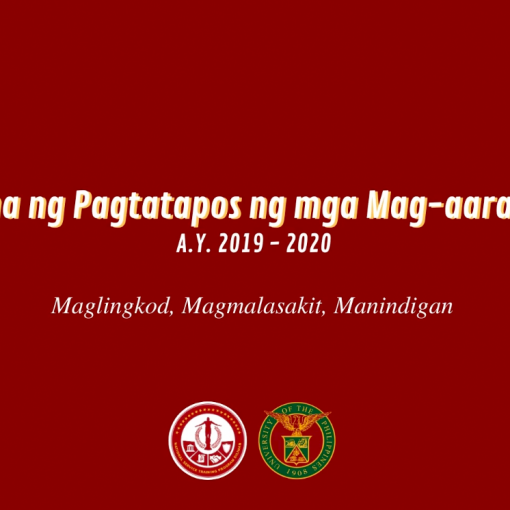In commemoration of the National Peace Consciousness Month held every September, the NSTP Diliman Office organized a webinar entitled “Kapayapaan: Peace Education and the Role of the NSTP in Peacebuilding” last September 24, via Zoom and YouTube Live. The webinar aimed to introduce peace education—what it is and how it is contextualized in Philippine universities—as a new common module topic for NSTP.
Together with staunch peace advocates Dr. Jasmin Nario-Galace (Miriam College), Dr. Herbert B. Rosana (Bicol University), and Asst. Prof. Yasmira Moner (Mindanao State University – Iligan Institute of Technology), the webinar explored potential pathways to promote peacebuilding through peace education in Philippine universities and colleges.

480 participants entered the Zoom space, and almost 15,000 viewers were able to watch the engagement through YouTube Live. Bringing together participants from all over the country, the webinar shed light on how peace education is valuable in the peacebuilding process. It opened a wide range of discussion about its implementation: from the provision of training and support for teachers despite not being peace educators, to the challenge of possible peacebuilding projects during this remote and blended learning period.
Dr. Ma. Theresa Payongayong, Vice Chancellor for the Academic Affairs of the University of the Philippines Diliman, formally opened the event welcoming the speakers and the thousands of faculty and students representing various state universities and colleges (SUCs) in the country. She shared that UP Diliman, consistent with UP’s mandate to become a public service university, has provided supplementary knowledge products and instructional materials for various academic programs. As she had said, “For the past 18 months of adapting and adjusting to the new normal, peace is very much needed… and we are very much looking forward to ‘Healing as One Nation and Recovering as a Better Generation,’ as the theme for this year’s National Peace Consciousness Month.”
NSTP Diliman Office Director Asst. Prof. Dennis Quilala framed the peace education within the NSTP while underscoring the importance of teaching peace within the university. Setting the agenda for the webinar, Asst. Prof. Quilala also provided an overview of the Tatak UPD NSTP Common Module Topics and encouraged the participants to use this opportunity to explore how they can also integrate peace education in their institutions.
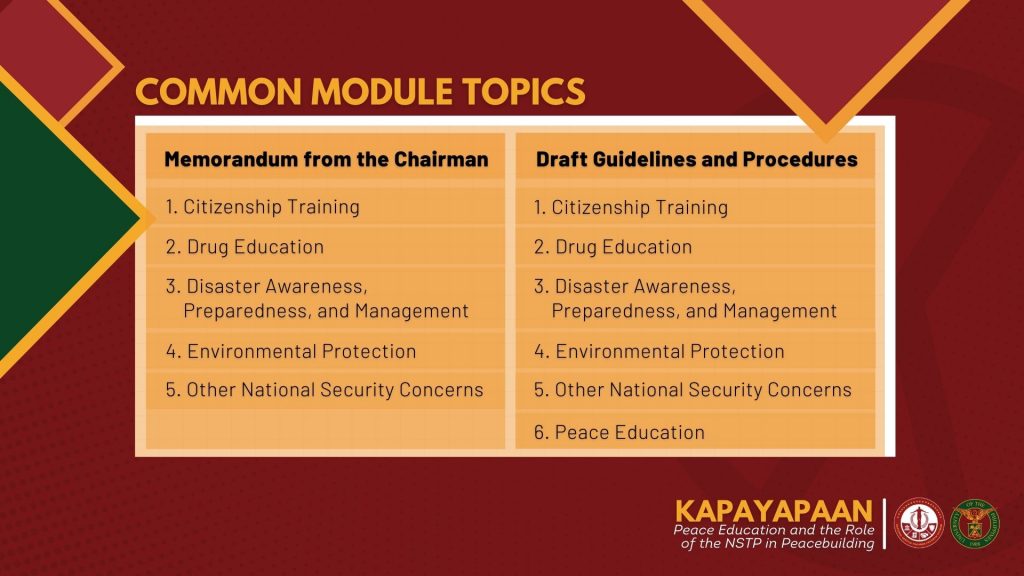

Peace is a relational process, and educating for peace is systematic and structural.
Asst. Prof. Yasmira Moner opened the discussion with her presentation on integrating “peace lens” on the prescribed common module topics of the NSTP. Early into the discussion, she motioned the need to understand the concept of peace education. She said that it should go beyond the usual treatment of teaching within the confines of the classroom. Much like how NSTP operates on the ground, peace education, she underscored, should be about embodying peace as a way of life. True peace education does not merely come from reading, rather, from steady, consistent doing.
“The role of the NSTP has always been to mold a citizenry that is not just disciplined but also humane and deliberately conscious of their roles as citizens. Through the careful injection of Peace Education into the revised module list, students, as well as teachers, are given a challenge to reflect on their own personal volitions as regards their civic duties.”
The same challenge has long been undertaken by the faculty of the Peace Studies program at Bicol University. As one of the pioneers in institutionalizing Peace Studies as a discipline, Dr. Herbert Rosana opened the second presentation with a brief history of how they were able to pilot a full straight course program in the Peace Studies Department. The focus now shifts to peace education as a formal degree program, in contrast with the previous iteration—the integration of peace education into the common module.
Dr. Rosana discussed how they implemented peace education into their curriculum. Echoing the same sentiment of Prof. Moner, Dr. Rosana highlighted the importance of a learning paradigm that allows for the theory and practice of peace to become tenets to live by. Nearing the end of his presentation, he claimed that subtle versions of some aspects of peace education can already be inferred from the previous module lists. Hinging on this, he then challenged participating NSTP units on how to integrate a multidisciplinary field of study like Peace Education into the revised NSTP module list without appearing redundant. He called on the facilitators to promote a standardized framework specifying how Peace Education can be taught considering the wide scope of Peace Studies.
Dr. Jasmin Nario-Galace opened her presentation by localizing the concept of “peace” in the Philippines. She reiterated how one’s teaching methods and devices should be consistent in teaching peace. As a study with many iterations and exhibitions in the real world, peace education is home to many projects and initiatives that help in creating a better future. The third and last presentation focused mainly on the question: how does one conceptualize a specific peace project in NSTP? To create the proper context, she shared her vast experience with a presentation of her projects with the Center for Peace Education (CPE) at Miriam College and the Peace Education Network.
The last part of the webinar focused on the opportunity to answer the questions raised by participants. The meeting room was split into three (3) to accommodate the different groups with questions for the resource speakers. Most of the inquiries were about the frameworks that they could use for their implementation of peace education. In response, the speakers gave the participants more insights, advice, and strategies in planning and implementing peace education in NSTP. This also presented an opportunity to collectively ponder future agendas for peace education. Most importantly, the presenters shared critical perspectives on how peace education would equip the citizens with the knowledge and skills to strive for peacebuilding as part of our civic duties.
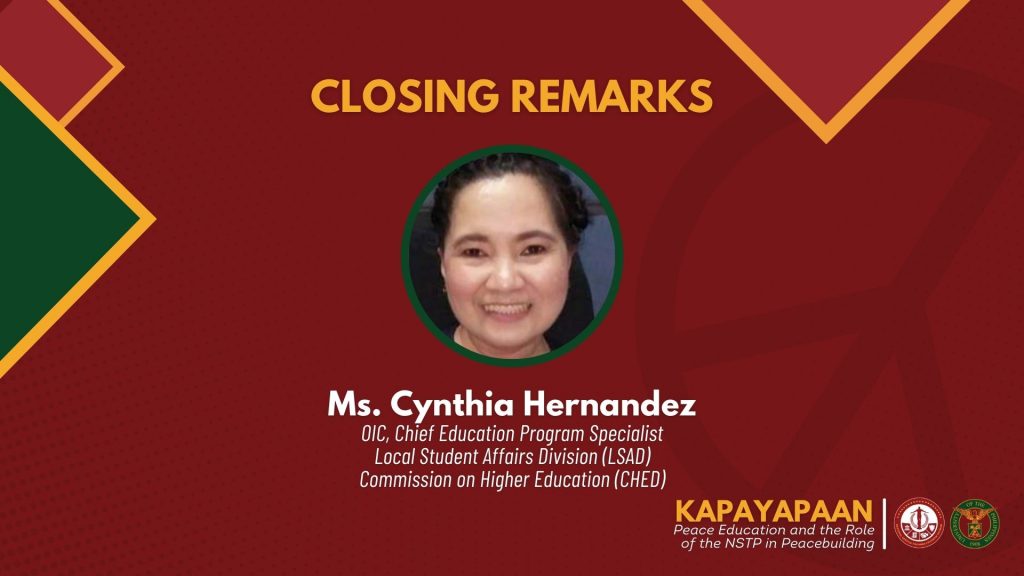
In her concluding remarks, Ms. Cynthia Hernandez, the Officer-in-Charge of the Local Student Affairs Division (LSAD) of the Commission on Higher Education (CHED), highlighted the initiatives of CHED in enhancing and aligning the NSTP Common Module Topics to what the society necessitated, including the focus on peace education under the CMO No. 1, 2019 – Integration of Peace Studies/Education into the Relevant Higher Education Curricula. She also imparted that due to the pandemic restrictions on face-to-face interactions, measures were taken to adapt and recalibrate into a more flexible method of implementing NSTP. Lastly, she thanked the officials, presenters, and attendees for participating in what she remarked as “a highly informative and timely webinar.” As she looks forward to more initiatives, projects, and collaborations for the betterment of NSTP, she further emphasized that the great number of participating HEIs and SUCs is proof of our willingness to push through and realize our civic duties through NSTP despite these trying times.
Watch the video of the webinar here: https://www.youtube.com/watch?v=0eifkcDgyfA
By Dolly Dolot & Carina Merin



